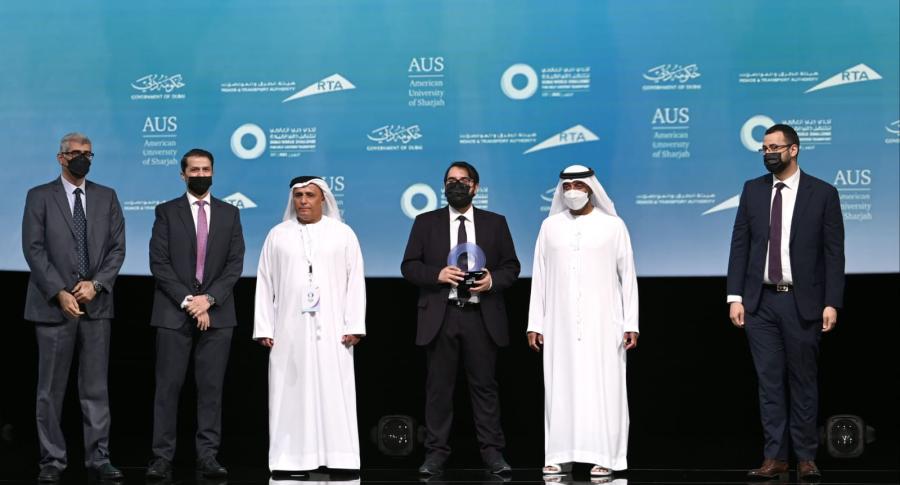- About
- Admissions
- Study at AUS
- Prospective Students
- Bachelor's Degrees
- Master's Degrees
- Doctoral Degrees
- Admission Publications
- International Students
- Contact Admissions
- Grants and Scholarships
- Sponsorship Liaison Services
- Testing Center
- New Student Guide
- File Completion
- New Student Orientation
- Payment Guide
- Executive Education
- Students with Disabilities
- Academics
- Life at AUS
- Research
- Contact Us
- Apply Now
- .

AUS engineering team wins second place at self-driving transport world challenge
An autonomous ground vehicle that can transport goods from vendors to customers designed by a team of engineering students and faculty at American University of Sharjah (AUS) came in second in the academic category at the Dubai World Challenge for Self-Driving Transport.
 The winning team comprised Dr. Mohammad Jaradat, Professor in Mechanical Engineering and Mechatronics Engineering Graduate Program (MSMTR); Dr. Mamoun Abdel-Hafez, Professor and Head of the Department of Mechanical Engineering; mechatronics master’s students Nidal Sherif and Ammar Kiftaro; and Wasim Almasri, Mechatronics Engineering Alumnus and Mechanical Laboratory Instructor at AUS.
The winning team comprised Dr. Mohammad Jaradat, Professor in Mechanical Engineering and Mechatronics Engineering Graduate Program (MSMTR); Dr. Mamoun Abdel-Hafez, Professor and Head of the Department of Mechanical Engineering; mechatronics master’s students Nidal Sherif and Ammar Kiftaro; and Wasim Almasri, Mechatronics Engineering Alumnus and Mechanical Laboratory Instructor at AUS.
Hosted by the Dubai Roads and Transport Authority (RTA), the Dubai World Challenge for Self-Driving Transport is a multi-year international competition designed for industry leaders, start-ups and academia, tackling the transport challenges faced by global cities. It is a catalyst to achieve the vision of His Highness Sheikh Mohammed Bin Rashid al Maktoum, Vice President and Prime Minister of the UAE and Ruler of Dubai, to make 25 percent of all trips in Dubai smart and driverless by 2030.
The vehicle uses a combination of GPS receivers, inertial measurement units and vision sensors, along with other sensors and data logs.
“The autonomous vehicle is programmed to deliver customer orders from the vendor to the customer's door steps. The customer is provided with a pin code to allow them to open the vehicle’s compartment and take their items. Prior to leaving from the vendor’s office, the vehicle plans its optimal route to avoid congested roads. The GPS will help locate the vehicle and a Lidar and vision systems will ensure that the vehicle maneuvers safely through the road,” said. Dr. Abdel-Hafez.
The team is part of an intelligent autonomous systems research group at AUS. Its members are involved in several projects that aim to solve real-life problems. According to Dr. Jaradat, the group is currently working on enhancing the accuracy and operational safety of the autonomous vehicle and is aiming to target transportation of people through round-the-clock autonomous public transportation.
The transport challenge project was the first time master’s degree student Sherif had worked on automating a system of such scale. “Previous automation tasks I worked on were limited to specific parts of a system, but never a system in its entirety. This project helped me realize the hurdles that occur when trying to integrate different sub-systems together, but also made me more confident in my ability to create sophisticated autonomous systems,” he said.
Sherif was responsible for real-time implementation of the autonomous system.
“There are several tasks an autonomous vehicle/robot must complete successfully, such as obstacle avoidance, path planning and path following, and localization. My role was to program these tasks and to integrate the different systems together to ensure successful real-time operation,” he explained.
The project was a great opportunity for students to put into practice what they have been learning at university.
“The project allowed me to further explore my specialization and its applications. Participating in competitions and conferences is a great way for graduate students to know more about the latest developments happening in their area of study in the region,” Sherif said.
Noting the importance of the graduate students’ contribution to the project, Dr. Abdel-Hafez said,
“The hard work of our graduate students on the project proved essential to the delivery of the working autonomous vehicle successfully. It was impressive to witness how technically prepared our students were in supporting the deliverables of this project. Additionally, it is imperative that we involve students in such projects to transfer the know-how needed for them to support the UAE vision in innovation and entrepreneurship.”
Graduate students at AUS have opportunities to work on cutting-edge research alongside their professors while also completing the required coursework for their master’s or doctoral degrees. For more information on the graduate programs in mechanical engineering and mechatronics at AUS, please visit www.aus.edu/cen.

